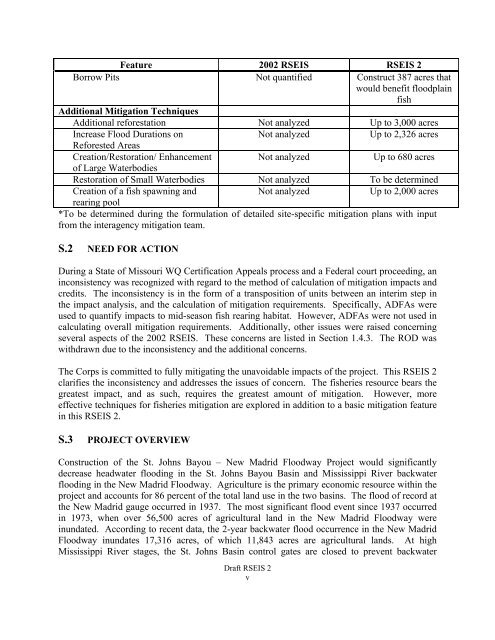St. Johns/New Madrid RSEIS - Endangered Species & Wetlands ...
St. Johns/New Madrid RSEIS - Endangered Species & Wetlands ...
St. Johns/New Madrid RSEIS - Endangered Species & Wetlands ...
You also want an ePaper? Increase the reach of your titles
YUMPU automatically turns print PDFs into web optimized ePapers that Google loves.
Feature 2002 <strong>RSEIS</strong> <strong>RSEIS</strong> 2<br />
Borrow Pits<br />
Additional Mitigation Techniques<br />
Not quantified Construct 387 acres that<br />
would benefit floodplain<br />
fish<br />
Additional reforestation Not analyzed Up to 3,000 acres<br />
Increase Flood Durations on<br />
Reforested Areas<br />
Not analyzed Up to 2,326 acres<br />
Creation/Restoration/ Enhancement<br />
of Large Waterbodies<br />
Not analyzed Up to 680 acres<br />
Restoration of Small Waterbodies Not analyzed To be determined<br />
Creation of a fish spawning and<br />
Not analyzed Up to 2,000 acres<br />
rearing pool<br />
*To be determined during the formulation of detailed site-specific mitigation plans with input<br />
from the interagency mitigation team.<br />
S.2 NEED FOR ACTION<br />
During a <strong>St</strong>ate of Missouri WQ Certification Appeals process and a Federal court proceeding, an<br />
inconsistency was recognized with regard to the method of calculation of mitigation impacts and<br />
credits. The inconsistency is in the form of a transposition of units between an interim step in<br />
the impact analysis, and the calculation of mitigation requirements. Specifically, ADFAs were<br />
used to quantify impacts to mid-season fish rearing habitat. However, ADFAs were not used in<br />
calculating overall mitigation requirements. Additionally, other issues were raised concerning<br />
several aspects of the 2002 <strong>RSEIS</strong>. These concerns are listed in Section 1.4.3. The ROD was<br />
withdrawn due to the inconsistency and the additional concerns.<br />
The Corps is committed to fully mitigating the unavoidable impacts of the project. This <strong>RSEIS</strong> 2<br />
clarifies the inconsistency and addresses the issues of concern. The fisheries resource bears the<br />
greatest impact, and as such, requires the greatest amount of mitigation. However, more<br />
effective techniques for fisheries mitigation are explored in addition to a basic mitigation feature<br />
in this <strong>RSEIS</strong> 2.<br />
S.3 PROJECT OVERVIEW<br />
Construction of the <strong>St</strong>. <strong>Johns</strong> Bayou – <strong>New</strong> <strong>Madrid</strong> Floodway Project would significantly<br />
decrease headwater flooding in the <strong>St</strong>. <strong>Johns</strong> Bayou Basin and Mississippi River backwater<br />
flooding in the <strong>New</strong> <strong>Madrid</strong> Floodway. Agriculture is the primary economic resource within the<br />
project and accounts for 86 percent of the total land use in the two basins. The flood of record at<br />
the <strong>New</strong> <strong>Madrid</strong> gauge occurred in 1937. The most significant flood event since 1937 occurred<br />
in 1973, when over 56,500 acres of agricultural land in the <strong>New</strong> <strong>Madrid</strong> Floodway were<br />
inundated. According to recent data, the 2-year backwater flood occurrence in the <strong>New</strong> <strong>Madrid</strong><br />
Floodway inundates 17,316 acres, of which 11,843 acres are agricultural lands. At high<br />
Mississippi River stages, the <strong>St</strong>. <strong>Johns</strong> Basin control gates are closed to prevent backwater<br />
Draft <strong>RSEIS</strong> 2<br />
v
















